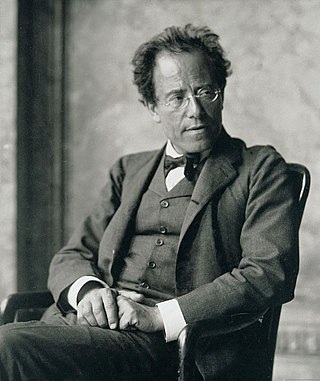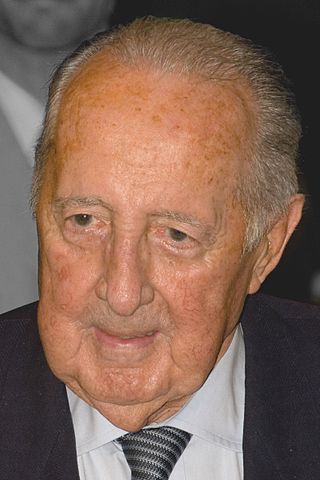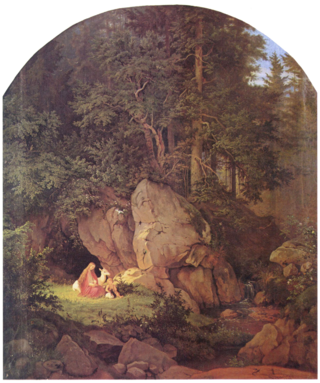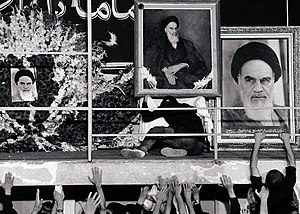
Ayatollah Ruhollah Musavi Khomeini was an Iranian Islamic revolutionary, politician, and religious leader who served as the first supreme leader of Iran from 1979 until his death in 1989. He was the founder of the Islamic Republic of Iran and the main leader of the Iranian Revolution, which overthrew Mohammad Reza Pahlavi and ended the Iranian monarchy.

Friedrich Gottlieb Klopstock was a German poet. His best known works are the epic poem Der Messias and the poem Die Auferstehung, with the latter set to text in the finale of Gustav Mahler's Symphony No. 2. One of his major contributions to German literature was to open it up to exploration outside of French models.

Evin Prison is a prison located in the Evin neighborhood of Tehran, Iran. The prison has been the primary site for the housing of Iran's political prisoners since 1972, before and after the Iranian Revolution, in a purpose-built wing nicknamed "Evin University" due to the number of students and intellectuals housed there. Evin Prison has been accused of committing "serious human rights abuses" against its political dissidents and critics of the government.

The Iranian Revolution, also known as the Islamic Revolution, was a series of events that culminated in the overthrow of the Pahlavi dynasty in 1979. The revolution also led to the replacement of the Imperial State of Iran by the present-day Islamic Republic of Iran, as the monarchical government of Mohammad Reza Pahlavi was superseded by the theocratic government of Ayatollah Ruhollah Khomeini, a religious cleric who had headed one of the rebel factions. The ousting of Pahlavi, the last Shah of Iran, formally marked the end of Iran's historical monarchy.

Ali Akbar Hashimi Bahramani Rafsanjani was an Iranian politician and writer who served as the fourth president of Iran from 1989 to 1997. One of the founding fathers of the Islamic Republic, Rafsanjani was the head of the Assembly of Experts from 2007 until 2011 when he decided not to nominate himself for the post. He was also the chairman of the Expediency Discernment Council.

Das Lied von der Erde is an orchestral song cycle for two voices and orchestra written by Gustav Mahler between 1908 and 1909. Described as a symphony when published, it comprises six songs for two singers who alternate movements. Mahler specified that the two singers should be a tenor and an alto, or else a tenor and a baritone if an alto is not available.

Slime, a German punk rock band founded in Hamburg in 1979, became a defining band in the 1980s German punk scene, and is the most widely recognized example of the musical style Deutschpunk.

Naser al-Din Shah Qajar was the fourth Shah of Qajar Iran from 5 September 1848 to 1 May 1896 when he was assassinated. He was the son of Mohammad Shah Qajar and Malek Jahan Khanom and the third longest reigning monarch in Iranian history after Shapur II of the Sassanid dynasty and Tahmasp I of the Safavid dynasty. Nasser al-Din Shah had sovereign power for close to 51 years.

The Guardianship of the Islamic Jurist is a concept in Twelver Shia Islamic law which holds that until the reappearance of the "infallible Imam", at least some of the "religious and social affairs" of the Muslim world should be administered by righteous Shi'i jurists (Faqīh). Shia disagree over whose "religious and social affairs" are to be administered and what those affairs are.
"The Faithful Hussar" is a German song based on a folk song known in various versions since the 19th century. In its current standard form, it is a song from the Cologne Carnival since the 1920s.

Khomeinism refers to the religious and political ideas of the leader of the 1979 Iranian Islamic Revolution, Ruhollah Khomeini. In addition, Khomeinism may also refer to the ideology of the clerical class which has ruled the Islamic Republic of Iran, founded by Khomeini. It can also be used to refer to the "radicalization" of segments of the Twelver Shia populations of Iran, Iraq, and Lebanon, and the Iranian government's "recruitment" of Shia minorities in Afghanistan, Pakistan, Saudi Arabia and Africa. The words Khomeinist and Khomeinists, derived from Khomeinism, can also be used to describe members of Iran's clerical rulers and attempt to differentiate them from "regular" Shia Muslim clerics.

Peter Roman Scholl-Latour was a French-German journalist, author and reporter.

Between 1716 and 1767, Georg Philipp Telemann wrote a series of Passions, musical compositions reflecting on Christ's Passion – the physical, spiritual and mental suffering of Jesus from the hours prior to his trial through to his crucifixion. The works were written for performance in German churches in the days before Easter. A prolific composer, Telemann wrote over 40 Passions for the churches of Hamburg alone, of which 22 have survived according to the present state of research. He also wrote several Passion oratorios. Unlike the Passions intended for liturgical performance, they were not closely set to the literal text of the Gospels.

Johann Sebastian Bach composed the church cantata Komm, du süße Todesstunde, BWV 161, in Weimar for the 16th Sunday after Trinity, probably first performed on 27 September 1716.

The German Forest was a phrase used both as a metaphor as well as to describe in exaggerated terms an idyllic landscape in German poems, fairy tales and legends of the early 19th-century Romantic period. Historical and cultural discourses declared it as the symbol of Germanic-German art and culture, or as in the case of Heinrich Heine or Madame de Staël, as a counter-image of French urbanity. It was also used with reference to historical or legendary events in German forests, such as Tacitus' description of the Battle of the Teutoburg Forest or even the nature mysticism of the stylized Germanic national myth, the Nibelungenlied as the history of its multi-faceted reception shows.

Ruhollah Khomeini’s return to Iran on 1 February 1979, after 14 years in exile, was an important event in the Iranian Revolution. It led to the collapse of the provisional government of Shapour Bakhtiar and the final overthrow of the Shah of Iran, Mohammad Reza Pahlavi, on 11 February 1979.

On 8 January 2017, Akbar Hashemi Rafsanjani, the fourth President of Iran and the country's Chairman of Expediency Discernment Council, died at the age of 82 after suffering a heart attack. He was transferred unconscious to a hospital in Tajrish, north Tehran. Attempts at cardiopulmonary resuscitation for more than an hour trying to revive him were unsuccessful and he died at 19:30 local time (UTC+3:30).
Peter Beauvais was a German television film director and scriptwriter. As a director for three decades, he helped pioneer and significantly influenced the development of German television.
Wolfgang Kermer is a German art historian, artist, art educator, author, editor, curator of exhibitions, art collector and professor. From 1971 to 1984 he was repeatedly elected Rector of the State Academy of Fine Arts Stuttgart and thus the first scientific and at the same time youngest teacher in this position in the history of the university. Under his rectorate, the State Academy of Fine Arts Stuttgart was reformed in 1975 and 1978 on the base of two new university laws of the State of Baden-Württemberg and thus, for the first time in its history, authorized to set up diplomas for all courses. One of the accents of his work was the promotion of talented graduates of the academy: In 1978 he organized the first of the so-called ″debutant exhibitions″, an ″unconventional contribution to the promotion of young people″, supported financially by the State of Baden-Württemberg.

Zoë Beck is a German writer, publisher, translator, dialogue book author and dubbing director. She has won multiple awards for her books and translations.


















